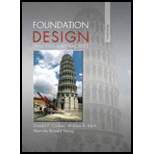
Concept explainers
A two-story reinforced concrete building is to be built on a vacant parcel of land. This building will be 100 ft wide and 200 ft long. Based on information from Other borings on adjacent properties, you are reasonably certain that the soils below a depth of 5 to 8 ft (1.5 - 2.5 m) are strong and relatively incompressible. However, the upper soils are questionable because several uncompacted fills have been found in the neighborhood. Not only are these uncompacted fills loose, they have often contained various debris such as wood, rocks, and miscellaneous trash. However, none of these deleterious materials is present at the ground surface at this site. Plan a site investigation program for this project and present your plan in the form of written instructions to your field crew. This plan should include specific instructions regarding what to do, where to do it, and any special instructions. You should presume that the field crew is experienced in soil investigation work, but is completely unfamiliar with this site.
Want to see the full answer?
Check out a sample textbook solution
Chapter 4 Solutions
Foundation Design: Principles and Practices (3rd Edition)
Additional Engineering Textbook Solutions
Electric Circuits. (11th Edition)
Vector Mechanics For Engineers
Vector Mechanics for Engineers: Statics and Dynamics
Degarmo's Materials And Processes In Manufacturing
Fluid Mechanics: Fundamentals and Applications
Elementary Surveying: An Introduction To Geomatics (15th Edition)
- - Find reactions and draw Shear and Bending Moment Diagram. 30 N 15 N/m D B A 2 m 1 m 2 mmarrow_forward: A 5ms- long current pulse is desired for two linear lamps connected in series and pumped at a total energy input of (1KJ). Each of lamps has an arc-length of (10cm) and a bore of (1cm). If we assume a peak current of (i, -650A). Design a multiple mesh network including number of LC sections, inductance and capacitance per section and capacitor voltage. Laser designarrow_forwardWhat would be the best way to handle when a contractor misses a concrete pour deadline which causes delays for other contractors?arrow_forward
- Please solve manuallyarrow_forward. The free fall distance was 1753 mm. The times for the release and catch recorded on the fall experiments were in millisecond: 222.22 800.00 61.11 641.67 0.00 588.89 11.11 588.89 8.33 588.89 11.11 588.89 5.56 586.11 2.78 583.33 Calculate the time taken for the fall for each experiment. Calculate for each fall the acceleration based on time and distance. Calculate the mean of the accelerations. Give in the answer window the calculated mean of accelerations in m/s2.arrow_forwardneed help. explain plzarrow_forward
- -Design the traffic signal intersection using all red 2 second, for all phase the truck percent 5% for all movement, and PHF -0.95 Check for capacity only Approach Through volume Right volume Left volume Lane width Number of lane Veh/hr Veh/hr Veh/hr m North 700 100 150 3.0 3 south 600 75 160 3.0 3 East 300 80 50 4.0 R west 400 50 55 4.0 2arrow_forwardneed helparrow_forwardFor the beam show below, draw A.F.D, S.F.D, B.M.D A 2 N M 10 kN.m B 2 M Carrow_forward
- B: Find the numerical solution for the 2D equation below and calculate the temperature values for each grid point shown in Fig. 2 (show all steps). (Do only one trail using following initial values and show the final matrix) T₂ 0 T3 0 I need a real solution, not artificial intelligence locarrow_forward: +0 العنوان use only Two rods fins) having same dimensions, one made orass (k = 85 Wm K) and the mer of copper (k = 375 W/m K), having of their ends inserted into a furna. At a section 10.5 cm a way from furnace, the temperature of brass rod 120 Find the distance at which the ame temperature would be reached in the per rod ? both ends are ex osed to the same environment. ns 2.05 ۲/۱ ostrararrow_forwardI need a real solution, not artificial intelligencearrow_forward
 Principles of Geotechnical Engineering (MindTap C...Civil EngineeringISBN:9781305970939Author:Braja M. Das, Khaled SobhanPublisher:Cengage Learning
Principles of Geotechnical Engineering (MindTap C...Civil EngineeringISBN:9781305970939Author:Braja M. Das, Khaled SobhanPublisher:Cengage Learning
